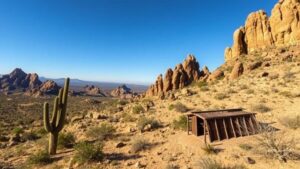The Treasure of Lima’s Gold Cross: Pirate Maps and Submarine Technology Search for Lost Spanish Loot
The Treasure of Lima’s Gold Cross: Pirate Maps and Submarine Technology Search for Lost Spanish Loot
The Treasure of Lima, a legendary trove of gold and valuable artifacts, has fascinated treasure hunters for centuries. At its heart is the Gold Cross, an emblematic artifact that signifies the wealth lost to the depths of the sea. This article will explore the historical context of the treasure, the intriguing pirate maps that lead to its location, and the modern submarine technology employed in the search for this coveted loot.
Historical Context of the Treasure of Lima
The Treasure of Lima dates back to the early 19th century, specifically around 1820 when the Spanish Government feared that their colonial possessions in South America would fall into the hands of revolutionary forces. In a concerted effort to safeguard their riches, a shipment of gold, silver, and priceless religious artifacts, including intricate crosses and chalices, was amassed in Lima, Peru.
This collection was intended to be transported by ship back to Spain. But, the ship, La Virgen de la Merced, never reached its destination. Instead, it was intercepted by a notorious English pirate, William Thompson, who seized the treasure and subsequently buried it on Cocos Island, located off the coast of Costa Rica. total estimated value of the treasure has been speculated to be up to $200 million, including the elaborate Gold Cross made from solid gold.
The Allure of Pirate Maps
Treasure maps have a unique allure; they are often shrouded in mystery, temptation, and adventure. In the case of the Treasure of Lima, various maps and accounts of the treasures location have circulated over time. These maps have been both a lure to treasure hunters and a source of contention among them.
Some narratives suggest that Thompson himself created a map before his demise, giving details of the golds resting place. Despite multiple claims to have found the true map, none have been validated definitively. The enduring intrigue lies in the discrepancies of accounts, leading to multiple expeditions trying to locate the buried bounty.
- In the late 19th century, treasure hunters began to flock to Cocos Island, persuaded by newspaper articles and word of mouth that touted the potential riches.
- In 1934, treasure hunter August Gissler claimed to have discovered the Gold Cross, stating he had unearthed it on the island, though many disputed the legitimacy of his claim.
Modern Submarine Technology in Treasure Hunting
With advances in technology, the search for the Treasure of Lima has transitioned from mere speculation to a sophisticated operation leveraging modern submarine technologies. One such innovation is the use of remotely operated vehicles (ROVs), which provide detailed sonar mapping and high-resolution imaging of underwater topographies.
- ROVs like the Triton 3300/3 have been used to explore the submerged regions around Cocos Island, capable of descending to depths of 3,300 meters with advanced imaging systems.
- Sonar technology, such as side-scan sonar, allows treasure hunters to create detailed maps of the ocean floor, identifying potential areas of interest absent of human interference, which can lead to successful excavation.
A notable case study in this regard is the work done by explorer and filmmaker Phil Mershon, who utilized ROVs and sonar technology in an expedition that sought to rediscover the lost treasure. Despite not uncovering the Gold Cross, the expedition provided invaluable data on the underwater landscape, enhancing future search strategies.
Legal and Ethical Considerations
When speaking of treasure hunting, it is essential to address the legal and ethical concerns involved. The search for the Treasure of Lima is not merely a quest for gold; it encompasses issues of cultural heritage, environmental impact, and the rights of sovereign states. As many of the artifacts contribute to historical knowledge about Spanish colonialism and indigenous practices, their looting can be seen as detrimental to cultural preservation.
Plus, many countries have laws regarding underwater archaeology and treasure recovery, requiring permits and adherence to environmental regulations. Its crucial for treasure hunters to engage with local authorities and historians to respect the intricate tapestry of history the treasure represents.
Actionable Takeaways
The enduring legend of The Treasure of Lima and the pursuit of the Gold Cross represent not just a quest for riches but a sophisticated interaction of history, technology, and ethics. For those interested in treasure hunting or archaeology, here are several actionable takeaways:
- Engage with local histories and narratives to fully appreciate the cultural significance of treasures.
- Use modern technology responsibly, ensuring environmental practices and legal regulations are followed.
- Consider the implications of finding treasure; engage historians and archaeologists in the quest to uncover not just riches, but also stories.
The Treasure of Lima may still lie hidden beneath the waves, its location obscured by time and myth. But, as technology advances and interest persists, the hope of discovering the Gold Cross and reviving its historical context continues to inspire treasure hunters and historians alike.


